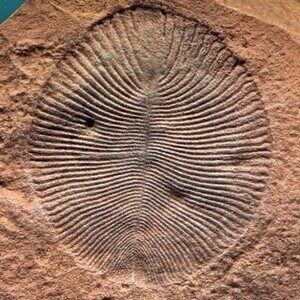Dickinsonia costata
First described by Reg Sprigg in 1947, Dickinsonia costata was first described from the late Ediacaran of South Australia. It lived in shallow, sandy marine environments on what was formerly the sea floor. The scanned specimen is from South Australia.
Dickinsonia costata, one of the most common taxa, is an apparently bilaterally-symmetrical organism found in the Ediacara Member of the Rawnsley Quartzite, Flinders Ranges, South Australia and the White Sea in Russia (~555 Ma). Leaving ‘footprints’ behind, Dickinsonia is thought to have fed by external digestion of the underlying microbial mat, creating a perfect impression, left behind when moving onto fresh mat ahead. This oval shaped organism reached 10 cm in length.
Specimen number: SAMA P40135
Geological age: Ediacaran
State/territory: South Australia
Locality/site: Flinders Ranges
(Text: Tory L. Botha and Diego C. García-Bellido, UofA and SAM)
